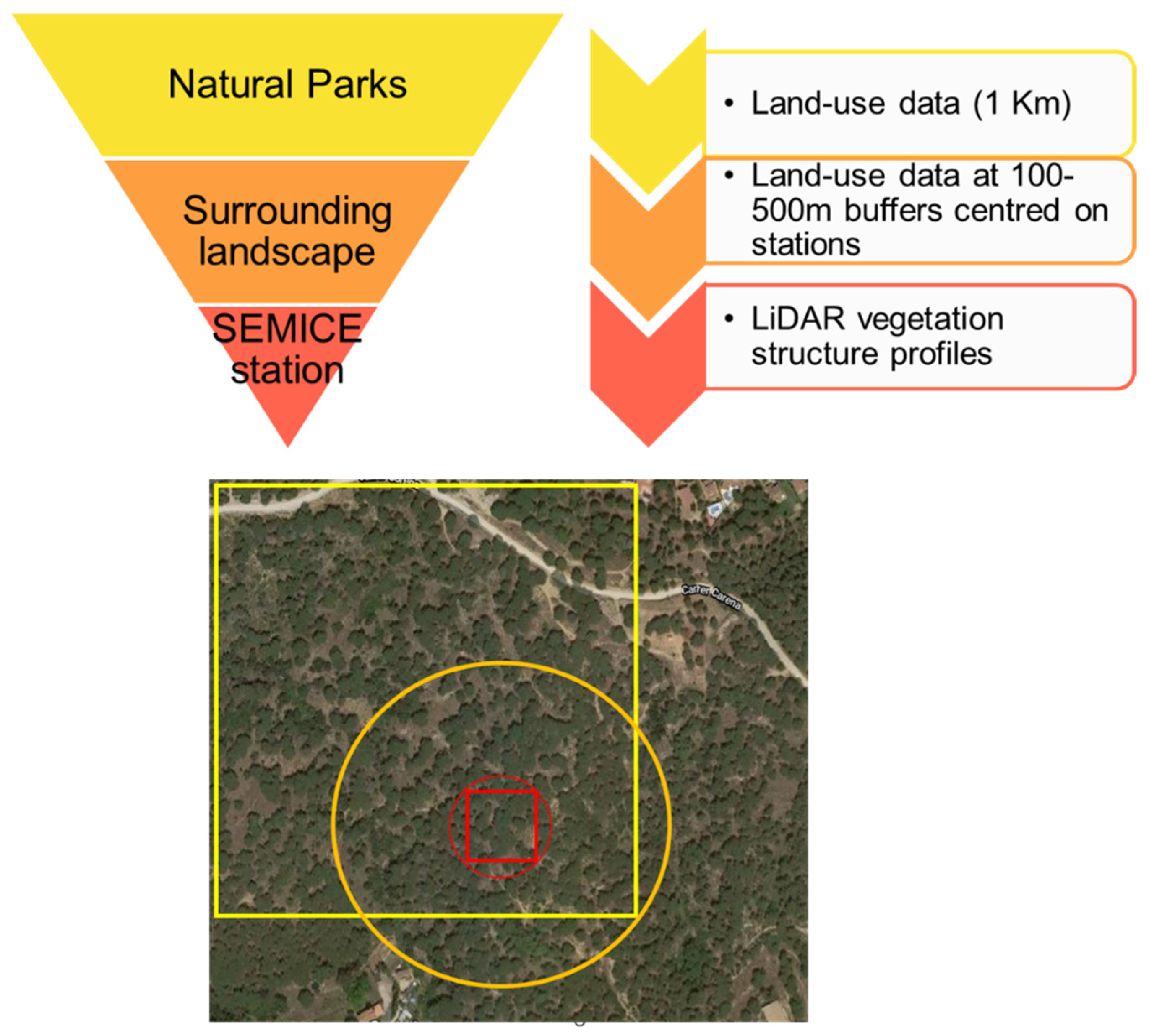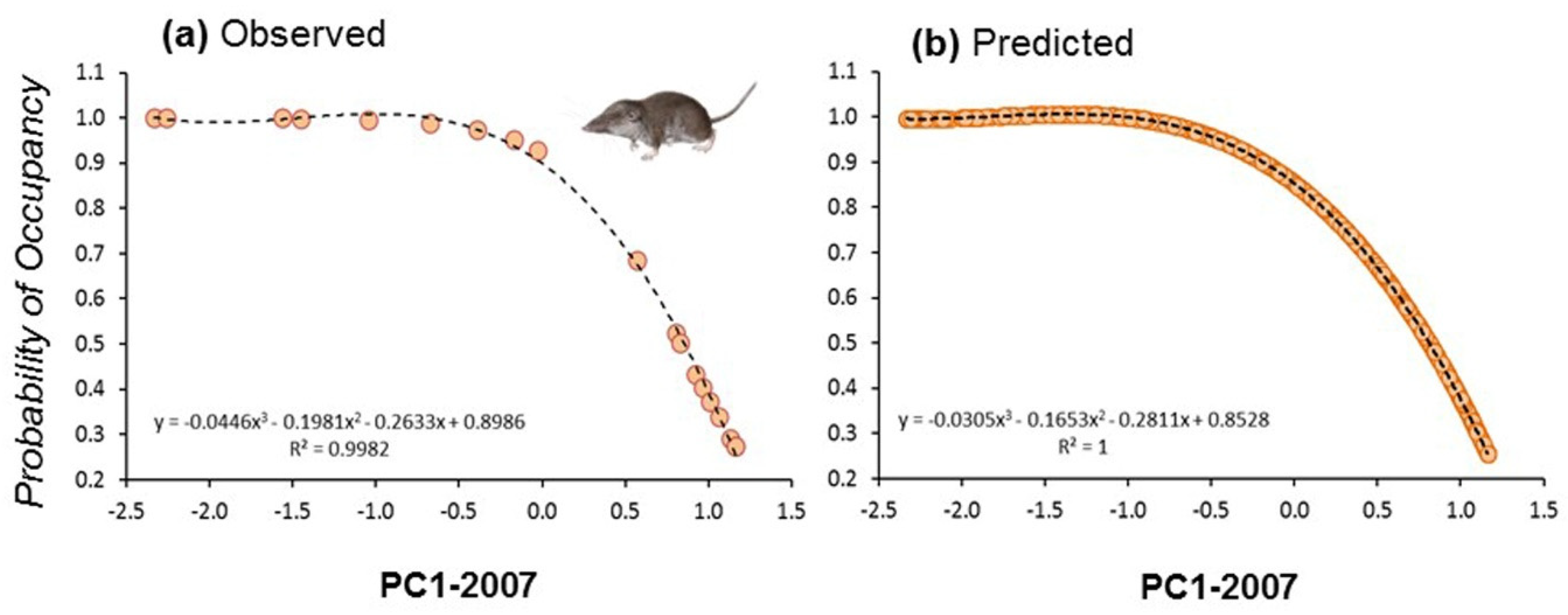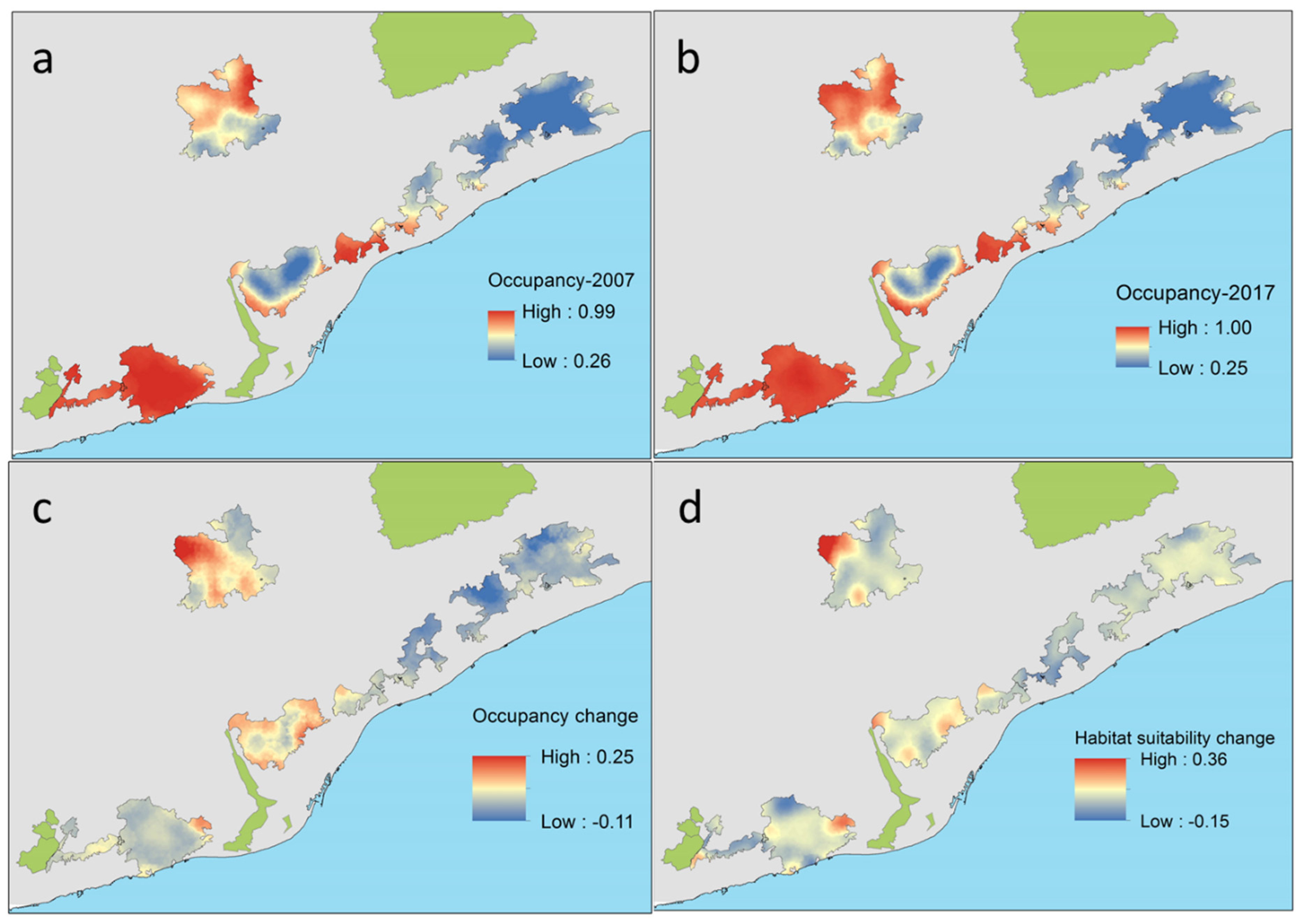Assessing the Effects of Landscape Change on the Occupancy Dynamics of the Greater White-Toothed Shrew Crocidura russula
Abstract
:1. Introduction
2. Materials and Methods
2.1. Study Area
2.2. Small Mammal Sampling
2.3. Vegetation Structure and Land-Use
2.4. Occupancy Analysis
3. Results
3.1. Patterns of Land Use Change
3.2. Vegetation Structure and Land Use of the Sampling Stations
3.3. Occupancy and Spatial Distribution Models
4. Discussion
Supplementary Materials
Author Contributions
Funding
Institutional Review Board Statement
Data Availability Statement
Acknowledgments
Conflicts of Interest
References
- Newbold, T.; Hudson, L.N.; Hill, S.L.L.; Contu, S.; Lysenko, I.; Senior, R.A.; Börger, L.; Bennett, D.J.; Choimes, A.; Collen, B.; et al. Global effects of land use on local terrestrial biodiversity. Nature 2015, 520, 45–50. [Google Scholar] [CrossRef] [PubMed]
- Baśnou, C.; Álvarez, E.; Bagaria, G.; Guardiola, M.; Isern, R.; Vicente, P.; Pino, J. Spatial patterns of land use changes across a mediterranean metropolitan landscape: Implications for biodiversity management. Environ. Manag. 2013, 52, 971–980. [Google Scholar] [CrossRef] [PubMed]
- Díaz, M.; Aycart, P.; Ramos, A.; Carricondo, A.; Concepción, E.D. Site-based vs. species-based analyses of long-term farmland bird datasets: Implications for conservation policy evaluations. Ecol. Indic. 2022, 140, 109051. [Google Scholar] [CrossRef]
- Blondel, J. The “design” of Mediterranean landscapes: A millennial story of humans and ecological systems during the historic period. Hum. Ecol. 2006, 34, 713–729. [Google Scholar] [CrossRef]
- Presley, S.J.; Cisneros, L.M.; Klingbeil, B.T.; Willig, M.R. Landscape ecology of mammals. J. Mammal. 2019, 100, 1044–1068. [Google Scholar] [CrossRef]
- Pereira, H.M.; Navarro, L.M. Rewilding European Landscapes; Springer International Publishing: Berlin/Heidelberg, Germany, 2015; ISBN 9783319120393. [Google Scholar]
- Ricotta, C.; Carranza, M.L.; Avena, G.; Blasi, C. Quantitative comparison of the diversity of landscapes with actual vs. potential natural vegetation. Appl. Veg. Sci. 2000, 3, 157–162. [Google Scholar] [CrossRef]
- Doblas-Miranda, E.; Martínez-Vilalta, J.; Lloret, F.; Álvarez, A.; Ávila, A.; Bonet, F.J.; Brotons, L.; Castro, J.; Curiel Yuste, J.; Díaz, M.; et al. Reassessing global change research priorities in mediterranean terrestrial ecosystems: How far have we come and where do we go from here? Glob. Ecol. Biogeogr. 2015, 24, 25–43. [Google Scholar] [CrossRef]
- Rowe, R.J. Legacies of land use and recent climatic change: The small mammal fauna in the mountains of Utah. Am. Nat. 2007, 170, 242–257. [Google Scholar] [CrossRef] [PubMed]
- Reed, J.M.; Mills, L.S., Jr.; Menges, E.S.; Kevin, S.; Frye, R.; Beissinger, S.R.; Anstett, M.; Miller, P. Issues in Population Viability Analysis. Conserv. Biol. 2014, 16, 7–19. [Google Scholar] [CrossRef]
- Mackenzie, D.L.; Nichols, J.D.; Royle, J.A.; Pollock, K.H.; Bailey, L.L.; Hines, J.E. Occupancy Estimation and Modeling Inferring Patterns and Dynamics of Species Occurrence; Elsevier: London, UK, 2018. [Google Scholar]
- Jaquiéry, J.; Guélat, J.; Broquet, T.; Berset-Brändli, L.; Pellegrini, E.; Moresi, R.; Hirzel, A.H.; Perrin, N. Habitat-quality effects on metapopulation dynamics in greater white-toothed shrews, Crocidura russula. Ecology 2008, 89, 2777–2785. [Google Scholar] [CrossRef] [PubMed]
- López-Fuster, M.J. Crocidura russula. In Atlas y Libro Rojo de los Mamíferos Terrestres de España; Palomo, L.J., Gisbert, J., Blanco, J.C., Eds.; Dirección General para la Biodiversidad-SECEM-SECEMU: Madrid, Spain, 2007. [Google Scholar]
- Torre, I.; Bastardas-Llabot, J.; Arrizabalaga, A.; Díaz, M. Population dynamics of small endotherms under global change: Greater white-toothed shrews Crocidura russula in Mediterranean habitats. Sci. Total Environ. 2020, 705. [Google Scholar] [CrossRef]
- González-Guerrero, O.; Pons, X. The 2017 Land Use/Land Cover Map of Catalonia based on Sentinel-2 images and auxiliary data. Rev. Teledetección 2020, 81–92. [Google Scholar] [CrossRef]
- MacKenzie, D.I. PRESENCE User Manual; 2012; pp. 1–35. Available online: https://www.mbr-pwrc.usgs.gov/software/doc/presence/presence_doc.pdf (accessed on 15 January 2022).
- Gil-Tena, A.; Brotons, L.; Saura, S. Effects of forest landscape change and management on the range expansion of forest bird species in the Mediterranean region. For. Ecol. Manag. 2010, 259, 1338–1346. [Google Scholar] [CrossRef]
- Regos, A.; D’Amen, M.; Titeux, N.; Herrando, S.; Guisan, A.; Brotons, L. Predicting the future effectiveness of protected areas for bird conservation in Mediterranean ecosystems under climate change and novel fire regime scenarios. Divers. Distrib. 2016, 22, 83–96. [Google Scholar] [CrossRef]
- Pino, J.; Basnou, C.; Vicente, P.; Isern, R.; Álvarez, E. Anàlisi en el Marc del SITxell dels Canvis en el Paisatge (1956–2005) i de la seva Repercussió en la Conservació dels Espais Naturals Protegits de la Província de Barcelona; Diputació de Barcelona and CREAF; 2013; pp. 1–67. [Google Scholar]
- Torre, I.; Raspall, A.; Arrizabalaga, A.; Díaz, M. SEMICE: An unbiased and powerful monitoring protocol for small mammals in the Mediterranean Region. Mamm. Biol. 2018, 88, 161–167. [Google Scholar] [CrossRef]
- Carrilho, M.; Teixeira, D.; Santos-Reis, M.; Rosalino, L.M. Small mammal abundance in Mediterranean Eucalyptus plantations: How shrub cover can really make a difference. For. Ecol. Manag. 2017, 391, 256–263. [Google Scholar] [CrossRef]
- Massoud, D.; Lao-Pérez, M.; Ortega, E.; Burgos, M.; Jiménez, R.; Barrionuevo, F.J. Divergent Seasonal Reproductive Patterns in Syntopic Populations of Two Murine Species in Southern Spain, Mus spretus and Apodemus sylvaticus. Animals 2021, 11, 243. [Google Scholar] [CrossRef] [PubMed]
- Torre, I.; Arrizabalaga, A. Species richness and abundance of small mammals along an elevational gradient of a Mediterranean mountain. Vie Milieu 2009, 59, 199–208. [Google Scholar]
- Torre, I.; Freixas, L.; Arrizabalaga, A.; Díaz, M. The efficiency of two widely used commercial live-traps to develop monitoring protocols for small mammal biodiversity. Ecol. Indic. 2016, 66, 481–487. [Google Scholar] [CrossRef]
- Caceres, N.C.; Napoli, R.P.; Hannibal, W. Differential trapping success for small mammals using pitfall and standard cage traps in a woodland savannah region of southwestern Brazil. Mammalia 2011, 75, 45–52. [Google Scholar] [CrossRef]
- Nicolas, V.; Colyn, M. Relative efficiency of three types of small mammal traps in an African rainforest. Belg. J. Zool. 2006, 136, 107–111. [Google Scholar]
- Machtinger, E.T.; Williams, S.C. Practical guide to trapping Peromyscus leucopus (Rodentia: Cricetidae) and Peromyscus maniculatus for vector and vector-borne pathogen surveillance and ecology. J. Insect Sci. 2020, 20, 5. [Google Scholar] [CrossRef] [PubMed]
- Gurnell, J.; Flowerdew, J.R. Live Trapping Small Mammals: A Practical Guide. In Mammal Society Occasional Publications; The Mammal Society: London, UK, 2006; pp. 1–48. ISBN 9780906282540. [Google Scholar]
- Sikes, R.S. Animal Care and use Committee of the American Society of Guidelines of the American Society of Mammalogists for the use of wild mammals in research. J. Mammal. 2016, 97, 663–688. [Google Scholar] [CrossRef] [PubMed]
- Lefsky, M.A.; Cohen, W.B.; Parker, G.G.; Harding, D.J. Lidar Remote Sensing for Ecosystem Studies. Bioscience 2002, 52, 19–30. [Google Scholar] [CrossRef]
- Simonson, W.D.; Allen, H.D.; Coomes, D.A. Applications of airborne lidar for the assessment of animal species diversity. Methods Ecol. Evol. 2014, 5, 719–729. [Google Scholar] [CrossRef]
- Jaime-González, C.; Acebes, P.; Mateos, A.; Mezquida, E.T. Bridging gaps: On the performance of airborne LiDAR to model wood mouse-habitat structure relationships in pine forests. PLoS ONE 2017, 12, e0182451. [Google Scholar] [CrossRef] [PubMed]
- Torre, I.; Jaime-González, C.; Díaz, M. Habitat Suitability for Small Mammals in Mediterranean Landscapes: How and Why Shrubs Matter. Sustainability 2022, 14, 1562. [Google Scholar] [CrossRef]
- Gray, S.J.; Hurst, J.L.; Stidworthy, R.; Smith, J.; Preston, R.; MacDougall, R. Microhabitat and spatial dispersion of the grassland mouse (Mus spretus Lataste). J. Zool. 1998, 246, 299–308. [Google Scholar] [CrossRef]
- Gorosito, I.L.; Marziali Bermúdez, M.; Busch, M. Advantages of combining generalized linear models and occupancy models to find indicators of habitat selection: Small mammals in agroecosystems as a case study. Ecol. Indic. 2018, 85, 1–10. [Google Scholar] [CrossRef]
- Tarjuelo, R.; Morales, M.B.; Traba, J. Breadth and specialization in microhabitat selection: The case of the algerian mouse (Mus spretus) in central Spain. Rev. D’ecologie (La Terre La Vie) 2011, 66, 145–156. [Google Scholar]
- Holland, G.J.; Bennett, A.F. Occurrence of small mammals in a fragmented landscape: The role of vegetation heterogeneity. Wildl. Res. 2007, 34, 387–397. [Google Scholar] [CrossRef]
- Dytham, C. Choosing and Using Statistics. A Biologist’s Guide, 3rd ed.; Blackwell Science, Ed.; Wiley-Blackwell: Oxford, UK, 2011. [Google Scholar]
- Guillera-Arroita, G. Modelling of species distributions, range dynamics and communities under imperfect detection: Advances, challenges and opportunities. Ecography 2017, 40, 281–295. [Google Scholar] [CrossRef]
- Gibson, L.A. The importance of incorporating imperfect detection in biodiversity assessments: A case study of small mammals in an Australian region. Divers. Distrib. 2011, 17, 613–623. [Google Scholar] [CrossRef]
- Mackenzie, D.I.; Nichols, J.D.; Lachman, G.B.; Droege, S.; Royle, J.A.; Langtimm, C.A. Estimating site occupancy rates when detection probabilities are less than one. Ecology 2002, 83, 2248–2255. [Google Scholar] [CrossRef]
- Ferreras, P.; DÍaz-Ruiz, F.; Monterroso, P. Improving mesocarnivore detectability with lures in camera-trapping studies. Wildl. Res. 2018, 45, 505–517. [Google Scholar] [CrossRef]
- Torre, I.; Díaz, M.; Arrizabalaga, A. Additive effects of climate and vegetation structure on the altitudinal distribution of greater white-toothed shrews Crocidura russula in a Mediterranean mountain range. Acta Theriol. 2014, 59, 139–147. [Google Scholar] [CrossRef]
- Torre, I.; Gracia-Quintas, L.; Arrizabalaga, A.; Baucells, J.; Díaz, M. Are recent changes in the terrestrial small mammal communities related to land use change? A test using pellet analyses. Ecol. Res. 2015, 30, 813–819. [Google Scholar] [CrossRef]
- Seoane, J.; Carrascal, L.M. Interspecific differences in population trends of Spanish birds are related to habitat and climatic preferences. Glob. Ecol. Biogeogr. 2008, 17, 111–121. [Google Scholar] [CrossRef]
- Lalis, A.; Mona, S.; Stoetzel, E.; Bonhomme, F.; Souttou, K.; Ouarour, A.; Aulagnier, S.; Denys, C.; Nicolas, V. Out of Africa: Demographic and colonization history of the Algerian mouse (Mus spretus Lataste). Heredity 2019, 122, 150–171. [Google Scholar] [CrossRef]
- Araújo, M.B.; Guilhaumon, F.; Rodrigues Neto, D.; Pozo Ortego, I.; Calmaestra, R.G. Impactos, Vulnerabilidad y Adaptación al Cambio Climático de la Biodiversidad ESpañola 2. Fauna de Vertebrados; Dirección General de Medio Natural y Política Forestal, Ministerio de Medio Ambiente, y Medio Rural y Marino: Madrid, Spain, 2011.
- Osorio-Olvera, L.A.; Falconi, M.; Soberón, J. Sobre la relación entre idoneidad del hábitat y la abundancia poblacional bajo diferentes escenarios de dispersión. Rev. Mex. Biodivers. 2016, 87, 1080–1088. [Google Scholar] [CrossRef]
- Germain, J.; Gómez-Bolea, A.; Llimona, F. Collserola, més Enllà del Bosc. Trobada Científica sobre la Conservació dels Prats, els Conreus, les Brolles i les Màquies de Collserola. 2008. Available online: https://blogs.iec.cat/ichn/pdf/collserola.pdf (accessed on 15 May 2022).
- Riera, J.; Castell, C. Efectes dels incendis forestals recurrents sobre la distribució de dues espècies del Parc Natural del Garraf: El pi blanc (Pinus halepensis) i la savina (Juniperus phoenicea). Butlletí Inst. Catalana D’història Nat. 1997, 65, 105–116. [Google Scholar]
- Torre, I.; Pulido, T.; Vilella, M.; Díaz, M. Mesocarnivore distribution along gradients of anthropogenic disturbance in Mediterranean landscapes. Diversity 2022, 14, 133. [Google Scholar] [CrossRef]
- Holland, G.J.; Bennett, A.F. Differing responses to landscape change: Implications for small mammal assemblages in forest fragments. Biodivers. Conserv. 2009, 18, 2997–3016. [Google Scholar] [CrossRef]
- Herrando, S.; Anton, M.; Sardà-Palomera, F.; Bota, G.; Gregory, R.D.; Brotons, L. Indicators of the impact of land use changes using large-scale bird surveys: Land abandonment in a Mediterranean region. Ecol. Indic. 2014, 45, 235–244. [Google Scholar] [CrossRef]
- De Frenne, P.; Zellweger, F.; Rodríguez-Sánchez, F.; Scheffers, B.R.; Hylander, K.; Luoto, M.; Vellend, M.; Verheyen, K.; Lenoir, J. Global buffering of temperatures under forest canopies. Nat. Ecol. Evol. 2019, 3, 744–749. [Google Scholar] [CrossRef]
- Navarro, L.M.; Pereira, H.M. Rewilding abandoned landscapes in Europe. In Rewilding European Landscapes; Springer International Publishing: Berlin/Heidelberg, Germany, 2015; pp. 3–23. ISBN 9783319120393. [Google Scholar]
- Mason, T.H.E.; Pollard, C.R.J.; Chimalakonda, D.; Guerrero, A.M.; Kerr-Smith, C.; Milheiras, S.A.G.; Roberts, M.R.; Ngafack, P.; Bunnefeld, N. Wicked conflict: Using wicked problem thinking for holistic management of conservation conflict. Conserv. Lett. 2018, 11, e12460. [Google Scholar] [CrossRef] [PubMed]
- Tanner-McAllister, S.L.; Rhodes, J.; Hockings, M. Managing for climate change on protected areas: An adaptive management decision making framework. J. Environ. Manag. 2017, 204, 510–518. [Google Scholar] [CrossRef] [PubMed]








| NATURAL PARK | SCRUBLAND | WOODLAND | CROPS | URBAN |
|---|---|---|---|---|
| Garraf | −3.40 *** | 2.37 *** | 0.51 | 0.52 ** |
| Collserola | 0.00 | −1.02 | 0.26 | 0.76 *** |
| Serralada de Marina | −2.18 | 0.96 | −0.11 | 1.32 *** |
| Serralada Litoral | −8.58 *** | 5.90 *** | 1.58 * | 1.10 *** |
| Montnegre i el Corredor | −3.58 *** | 2.25 *** | 0.80 | 0.53 * |
| Sant Llorenç del Munt i l’Obac | −0.20 | −0.73 | 0.62 | 0.31 |
| TOTAL AREA | −2.66 *** | 1.33 *** | 0.67 * | 0.66 *** |
Publisher’s Note: MDPI stays neutral with regard to jurisdictional claims in published maps and institutional affiliations. |
© 2022 by the authors. Licensee MDPI, Basel, Switzerland. This article is an open access article distributed under the terms and conditions of the Creative Commons Attribution (CC BY) license (https://creativecommons.org/licenses/by/4.0/).
Share and Cite
Torre, I.; Díaz, M. Assessing the Effects of Landscape Change on the Occupancy Dynamics of the Greater White-Toothed Shrew Crocidura russula. Life 2022, 12, 1230. https://doi.org/10.3390/life12081230
Torre I, Díaz M. Assessing the Effects of Landscape Change on the Occupancy Dynamics of the Greater White-Toothed Shrew Crocidura russula. Life. 2022; 12(8):1230. https://doi.org/10.3390/life12081230
Chicago/Turabian StyleTorre, Ignasi, and Mario Díaz. 2022. "Assessing the Effects of Landscape Change on the Occupancy Dynamics of the Greater White-Toothed Shrew Crocidura russula" Life 12, no. 8: 1230. https://doi.org/10.3390/life12081230







